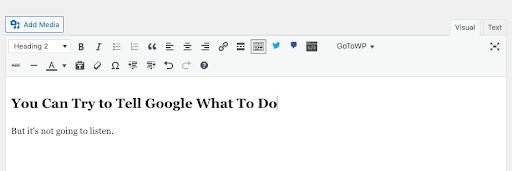
In a previous article, we investigated the evidence for H1 tags as a Google ranking factor.
Let’s take a look at the remaining heading tags, from H2 to H6.
Will using these tags help your content rank higher in Google search results?
And, can incorporating specific keywords into H2 to H6 tagged headings help you rank for those terms?
Let’s take a look.
H2-H6 Tags As A Ranking Factor
The belief is that the keywords used in H2-H6 subheadings are more heavily weighted in Google’s algorithm than words in plain text and that tags are thus a ranking factor in and of themselves.
Must Read: Are H1 Tags Considered a Google Ranking Factor?
The Evidence For HTML Heading Tags As A Ranking Factor
Subheadings did seem to count as ranking factors once upon a time, around 2005-2010. Including your target keywords in higher-level subheadings (typically your primary keyword in your H1 and secondary keywords in H2s and H3s) aided in your ranking for those keywords.
That was back when the text as a whole, as well as what you did with it, was given more weight.
For sites like Suite101, About.com, and WikiHow, using a specific keyword density and placing keywords in specific places was considered best practice. These sites were a nightmare for Google because much of the criteria it used to assess webpage quality worked in their favor.
With a solid technical foundation and the perceived authority that publishing massive amounts of content (and obtaining links to that content) provided, on-page SEO tactics like optimizing your subheadings were a recipe for high rankings that required only the addition of water.
Fast forward to August 2020, and Google’s John Mueller explicitly stated that headings are a ranking factor:
“So headings on a page help us to better understand the content on the page.
Headings on the page are not the only ranking factor that we have. We look at the content on its own as well.
But sometimes having a clear heading on a page gives us a little bit more information on what that section is about.”
He went on to say:
“And when it comes to text on a page, a heading is a really strong signal telling us this part of the page is about this topic.
…whether you put that into an H1 tag or an H2 tag or H5 or whatever, that doesn’t matter so much.”
The Case Against H2-H6 Tags As A Ranking Factor
If all you learned from the above interview excerpts is that Mueller believes heading tags is a strong signal, you probably believe they are far more valuable than they are.
We know that pages can rank even without any heading tags.
We all know that adding a specific keyword to a heading tag will not propel you to the top of Google’s rankings.
Mueller stated that heading tags:
- Assist Google in better understanding the content.
- Please provide Google with a little more information.
- Are a strong indicator of what a particular section of the page is about.
By incorporating more (and more complex) factors into the algorithm, Google has made significant progress toward developing a more nuanced understanding of each webpage.
It is constantly testing and updating the algorithm in order to better “understand” relevance, entity relationships, and searchers’ perceptions of a positive, high-quality experience.
And, as newer, more accurate methods of comprehending these complex issues were incorporated into the algorithm, those older signals were inevitably diluted.
Why? Because, like so many previous ranking signals – text formatting, keyword density, and.gov links, for example – subheadings are far too easy to manipulate.

Any information that you can explicitly “tell” Google can be used to manipulate the algorithm.
H2-H6 Tags As A Ranking Factor: Our Opinion
HTML heading tags are essential:
- The structural element that assists readers and search engines in navigating the content on each webpage.
- Accessibility aid – Heading tags assist browsers, plug-ins, and assistive technologies in navigating the page.
- A navigational tool. They can help to improve the user experience by emphasizing important information.
Although they are a proven ranking factor, including specific keywords in heading tags will not get you to the top of Google’s SERPs. To see any significant ranking impact, you’ll need to travel back to the first decade of this century in your time machine.
This one, like the H1, was abused and mishandled. Google caught on to all of the keyword stuffing, overuse, and sites attempting to hide heading tag HTML with CSS.
Do you want to get the most out of these page elements? Concentrate on the user experience benefits of heading tags and their utility in providing structure to your content.
Need help with our free SEO tools? Try our free Website Reviewer, Online Ping Website Tool, Page Speed Checker.
Learn more from SEO and read How to Use Python to Automate SEO Keyword Clustering Based on Search Intent.





One Comment